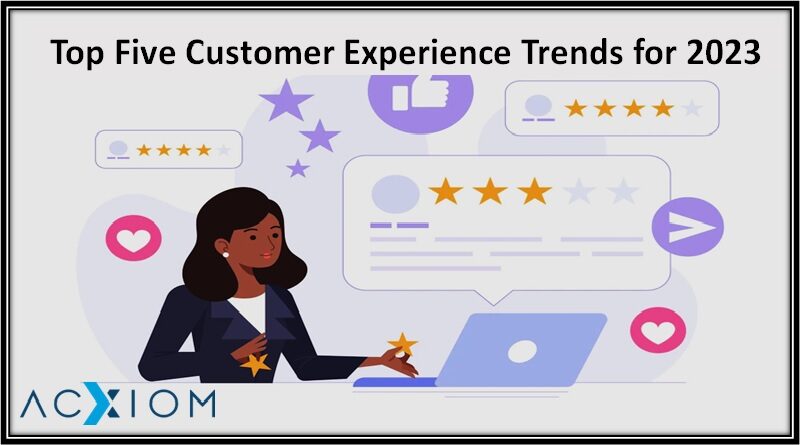Acxiom Forecasts Top Five Customer Experience Trends for 2023
Top Five Customer Experience Trends for 2023
Acxiom, a provider of consumer information, today released its top customer experience (CX) forecasts for 2023. Acxiom’s data-driven solutions foster business success by allowing better customer experiences. Beyond the Metaverse – Our CX Predictions for 2023 is based on Acxiom’s data-driven marketing expertise and incorporates insights from fresh, exclusive research that Acxiom commissioned from the worldwide research and strategy firm MTM.
“Our report underscores the crucial roles data and customer intelligence play in emerging CX trends and serves as a guide for brands looking to connect with and engage customers in 2023”, “After all, how brands and people interact is the cornerstone of every economy. Our research highlights this fundamental truth – it takes the right blend of data and technology to genuinely understand people. Regardless of trends, brands must have that essential mix to create customer experiences that resonate with people and drive brand growth.”
David Skinner, Chief Strategy Officer at Acxiom
The following are the top five CX forecasts made by Acxiom based on recent consumer and B2B research:
1. Everything-is-an-Ad-Network:
75% of organisations believe that first-party data is an asset that is worthwhile of investment because of the anticipated deprecation of third-party cookies, which will make it more difficult to target audiences. Retail media networks and other proprietary media networks based on owned first-party data will appeal to marketers trying to make money at every point in the consumer journey. Since adverts show when consumers are actively shopping and willing to spend money, more than half of businesses (55%) believe retail media networks will result in higher conversion rates. This is a compelling reason for companies who have already gathered a wealth of first-party data to start their own ad network.
2: Anything-as-a-Service (XaaS):
Through subscription-based platforms for goods and services that were formerly one-time purchases, XaaS has been gaining popularity for years. XaaS has been acknowledged by brands from all industries as a revolutionary tool for connecting with consumers at every stage of the customer journey. And according to MTM, the XaaS industry will expand even more in 2023 as businesses work to maintain their clientele. This will present a large opportunity for enterprises who sell their goods as services. Seventy-six percent (76%) of major firms believe that providing products as services enables them to build stronger bonds with clients and promotes customer loyalty. And the majority of individuals (57%) concur that this model provides a superior customer experience.
3: Seamless Service:
In order to meet the growing need for individualised and seamless customer care, automation and AI will be essential. Calls for AI-powered customer service continue to increase, particularly among younger age groups, with a majority of those aged 16-44 (56%) preferring their first point of contact to be with an AI chatbot rather than a person, and two-thirds expecting digital assistants to have access to all relevant information for their query. However, more than half of the 64% of organisations using AI for customer support report having siloed systems across channels, which may irritate customers. Maintaining interconnected systems is necessary for delivering smooth customer service, and in 2023, rising consumer expectations will put pressure on businesses to upgrade their connected, data-informed technology stack or risk losing market share.
4: Intuitive Technology:
The epidemic accelerated the development and use of touchless technology by crystallising its value proposition, such as speech and gesture recognition. These touchless interfaces will become more widely used by 2023. Sixty percent of consumers have used touchless technology, and 89% of individuals who use gestures urge firms to use more user-friendly interfaces to enhance the customer experience. Organizations are optimistic about the prospects that intuitive technologies offer, and 88% of larger businesses expect to offer more intuitive ways to communicate with clients, up from 70% of smaller businesses. This positive attitude is due to a number of factors, chief among them the ability to improve the client experience. According to 61% of US businesses, intuitive interfaces will enable them to provide experiences that are more fluid, responsive, and customised.
5: Immersive Shopping:
The use of augmented and virtual reality by brands to develop interactive, highly personalised shopping experiences is just getting started. Examples include virtual try-ons, virtual showrooms, 3D modelling, and visual search, in which users use their phones to shop the real world by simply taking images of objects to access internet information. Both consumers and businesses have the potential to gain from immersive shopping. It raises satisfaction and confidence levels for consumers.More over three-in-four (78%) of the 30% of people who say they’ve used an immersive shopping experience were happy with it, and 73% say it gives them more confidence when making purchases when they buy online. It can potentially lower returns for brands and serves as a channel for direct customer input and interaction. Immersive purchasing is crucial to boosting commercial efficiency at a time when businesses in many sectors are battling supply chain problems and rising expenses.




